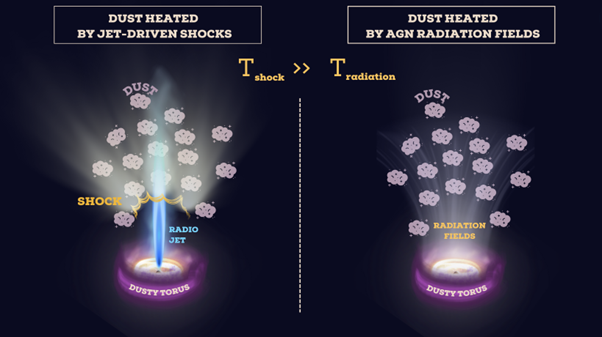dust near a supermassive black hole
JWST unveils the structure of dust near a supermassive black hole
Published on: 6 August 2024
A team of international scientists led by researchers at Newcastle University, have used the James Webb Space Telescope (JWST) to reveal a hidden veil of dust in a galaxy 70 million light years away.
This research has shown that, unexpectedly, the energy that heats the dust comes from collisions of gas flowing close to the speed of light (shocks), rather than by radiation from the supermassive black hole in the galaxy.
The research, led by Houda Haidar, a PhD student in the School of Mathematics, Statistics and Physics, has been published in the Monthly Notices of the Royal Astronomical Society (MNRAS). Houda and her team are members of the Galactic Activity, Torus, and Outflow Survey (GATOS), an international collaboration studying the centres of nearby galaxies using JWST. The team at Newcastle University has been working with some of the first dedicated JWST observations ever taken.
"Having the opportunity to work with exclusive JWST data and access these stunning images before anyone else is beyond thrilling,” said Houda. “I feel incredibly lucky to be part of the GATOS team. Working closely with leading experts in the field is truly a privilege.''

Dust near supermassive black holes
Astronomers define an active galactic nucleus (AGN) as a supermassive black hole, millions to billions the mass of the Sun, that grows by feeding on gas. In many AGN, the thick clouds of dust and gas that feed the nucleus, also block its view from observers on Earth. JWST’s infrared vision looks through this dust to reveal the hidden core. At the same time, the telescope's sharp eye allows us for the first time to resolve the detailed structure of this dust across hundreds of light years.
The new JWST images of ESO 428-G14 reveal that much of the dust near the supermassive black hole is spread out in along the radio jet. Unexpectedly, the research found a close relationship between the dust and the radio jet, suggesting that the jet itself may be responsible for heating and shaping the observed dust.
Dr David Rosario, Senior Lecturer at Newcastle University, and co-author of the study, said: ”There is a lot of debate as to how AGN transfer energy into their surroundings. We did not expect to see radio jets do this sort of damage. And yet here it is!''
By studying dust close to supermassive black holes, we are learning how galaxies recycle their material, which ultimately helps us understand the processes by which supermassive black holes influence galaxies, including our own.
Reference
Haidar, H. et al. (2024) ‘Dust beyond the torus: Revealing the mid-infrared heart of local Seyfert ESO 428-G14 with jwst/miri’, Monthly Notices of the Royal Astronomical Society, 532(4), pp. 4645–4660. doi:10.1093/mnras/stae1596
Image caption (bottom): A sketch showing the two scenarios (heating from shocks, left) vs illumination by AGN radiation fields. Shock heats the dust to temperatures comparable to that derived from the JWST images.




